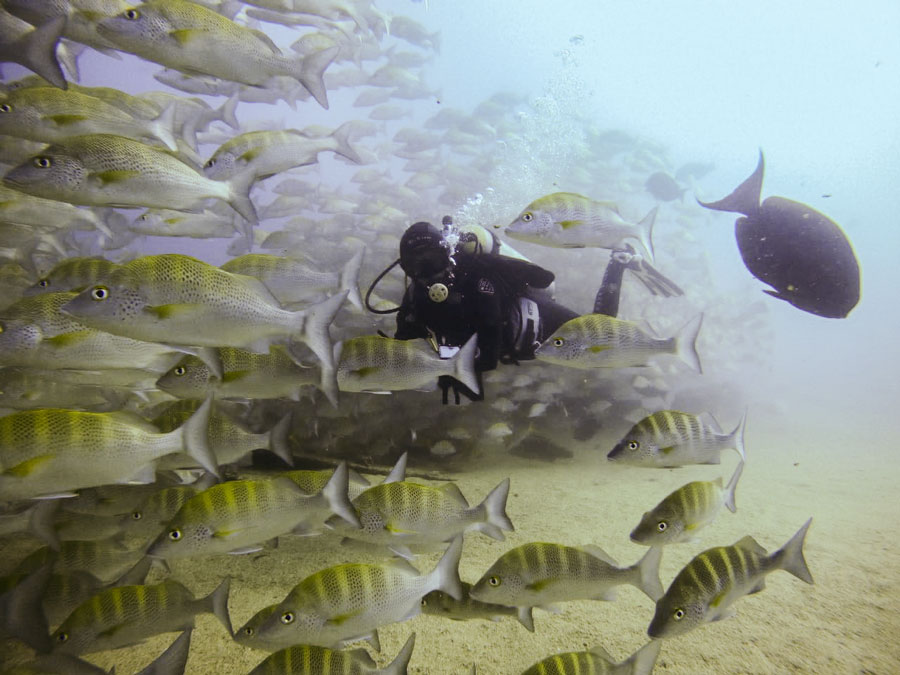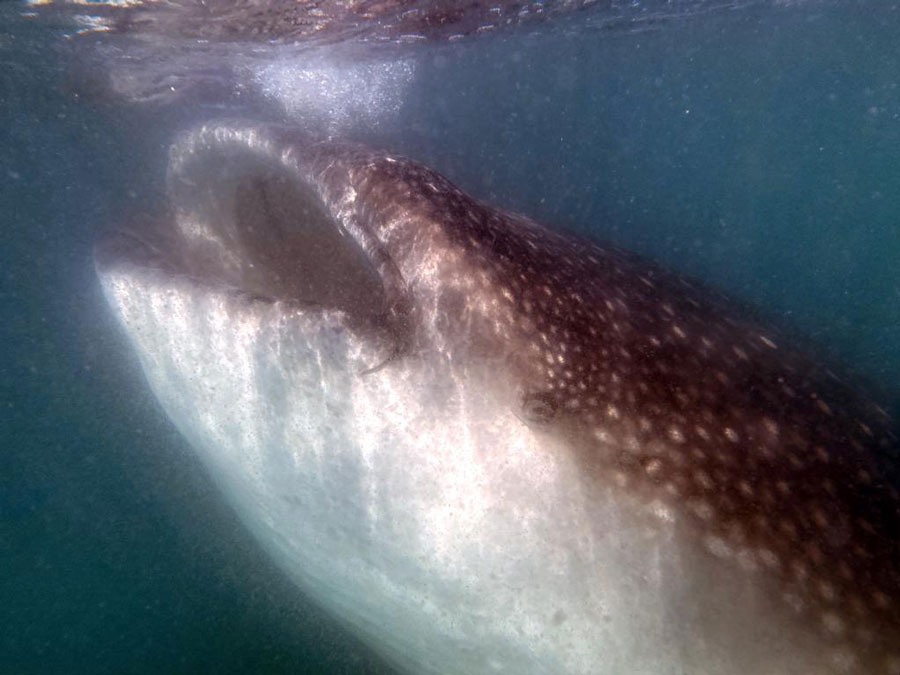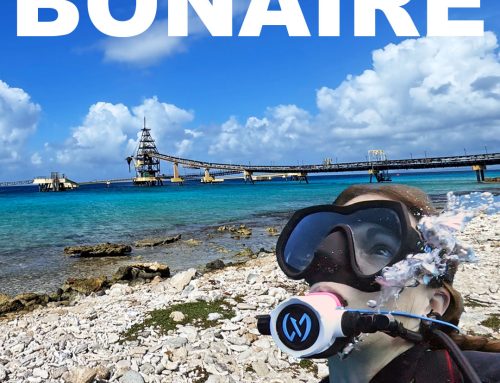Getting confident with diving in strong currents or surge usually just takes getting in the water and experiencing it. Still, there are a lot of things you can do to prepare yourself to have the safest dives possible.
Types of dives in strong current:
Drift
The dive site will be a wall or sloping reef. You will jump from a boat (or start from shore) and end the dive in a different location where the boat will pick you up. If you do a shore drift dive, you need to have pickup arranged at your exit point.
Diving in the split
The dive site will be a pinnacle. You will jump from a boat on the unprotected side of the reef and descend down to the split (where the current hits the pinnacle and splits around the rock. You will most likely use the current to get to the other side to finish the dive on the protected side where the boat can easily pick you up.
Pre dive tips:
Get in shape: Health is #1 for any strenuous activity, and especially for diving in strong currents. Being fit will give you the power and endurance to swim against the current, if necessary. Fitness also has a direct effect on air consumption.
Calm your mind: Regular meditation will help you stay calm in challenging environments. It can teach you to breathe deeply, be aware of your surroundings, and make grounded decisions.
Be familiar with your equipment: If you are nervous about going on your first dive in a strong current, take your own gear. You will be more comfortable breathing from your regulator and using your BCD/fins. If you can’t use your own equipment, at least take the time to become familiar with how everything works on your rental equipment, specifically where your dump valves are on your BCD.
Hone in your buoyancy: You need to comfortably hover in any position. I have a video about buoyancy which you can watch here. Practice before signing up for a dive in strong currents.
Plan your dive: Look at the tides, wind, and waves. Slack tide (where there is no current) is when tides shift from rising to falling or vice versa. There will be stronger currents when the tidal exchanges are bigger. Days around the full and new moons generally mean stronger currents.
Go with a knowledgeable buddy: I don’t recommend doing a ‘trust me’ dive where you’re just following your buddy, however going with someone with experience in the conditions is really helpful. That’s one of the reasons group travel is so great. During my KOMODO DIVE EXPEDITION, the experienced divers helped the less experienced divers, and we all got to learn more about diving in strong currents throughout the week.
Current checks: Someone should check the current when you arrive at the dive site to make sure it’s deemed safe from the surface. Whoever is checking the current will wear fins, mask, and snorkel, looking for indicators on the reef like soft coral or kelp to get an idea of the strength of the current. They can also look for fish swimming persistently against the current.
During the dive:
Tools
Reef hooks: I am not a fan of using reef hooks, but they exist and help people so I want you to know about them. A reef hook is a metal hook with a lanyard and a bolt snap attached to the opposite end. You place the hook on a sturdy rock on the reef and you can either hold on to the line or clip it to your bcd. I prefer to kick against the current and if I need to hold on, I will use my hands. I find that people using reef hooks use less discernment when choosing a spot to hook in and it can lead to reef breakage.
Good blade fins: Split fins do not belong in strong currents or big surges. I think that, like most things, split fins are tools that work for certain people under certain conditions, but they are useless when fighting against a strong current.
SMB: You should always have an SMB and if you’re dealing with rough surface conditions, the bigger, the better. I always like to have a whistle and mirror as well.
PLB or satellite communicator: If you dive in really remote places where you could surface with no one in sight, you should have one of these devices with you to send out an SOS.
Team diving
Communication: Stay within sight of one another and look at each other regularly. You won’t be able to hear tank banging as easily in strong currents. Discuss how you will communicate with one hand in case you are holding onto the reef. (Example of numbers for air)
Staying together: If you notice you’re going faster than your guide or buddy, you are probably higher in the water column where the current has more force. That brings us to your position in the water.
Diver position
When possible, stay low to the bottom or close to the wall without touching the reef.
Face into the current to swim against it.
My favorite position is:
Facing the reef with my body perpendicular to the current.
Depending on the topography, you can face the blue instead, but be aware of your fins so they’re not touching the reef. This works best for a gently sloping reef instead of a wall.
Hide behind big structures like rocks, sponges, or coral to take a break from the current or reconnect with the group if you’re getting ahead of them.
Safety
Be honest: If you are not feeling prepared for a dive in a strong current, say something. If you are overly stressed or having difficulty underwater, cancel the dive. Even great divers have off days and it’s ok to cancel a dive at any time.
Separations:
The standard 1-minute rule for buddy separations gets modified with strong currents. If you find yourself still on the reef, but you drift ahead of your team, find a place to hide and wait in one spot for them to catch up. If they get ahead of you, swim with the current to catch up. In either scenario, only do this for about 20 seconds. If you see no sign of bubbles, fins, etc, head up to the surface without the safety stop. We should be diving conservatively with strong currents so with proper dive planning, the safety stop is not required. If you are blown off the reef and find yourself in the blue, don’t waste time drifting and looking for your team. Head up to the surface at a normal pace, following your computer.
When you’re at the surface, make yourself positively buoyant and very visible. That’s why you should always have an SMB. Once at the surface, reconnect with your team and the boat, giving a big OK sign, if you are ok. If you are hurt, signal to the boat by waving your hands.
If you surface and your boat is not in sight, you can have another boat hail your boat (which is why it’s important to know the name of the vessel you’re diving on) or if you’re by yourself, you can send an SOS from your PLB/satellite phone.
Surface marking: If the current is so strong you can’t get your SMB out, take your octopus and blow a bunch of bubbles to warn boats of your ascent.
DCS risk: People can easily become overexerted in strong currents which can increase the risk of DCS. This is why it’s important to be fit, hydrated, and rested before attempting a dive in a strong current.
Get in the water
Ultimately, to learn how to dive in strong currents, you have to get in the water, experience the sensations, and learn how you respond to challenges. You just have to do the thing. Sign up for a guided dive or a group trip and gain the experience you need to be comfortable in these conditions. Challenging yourself in this way will make you a stronger diver.
Join me on upcoming Azul Unlimited dive expeditions
See what trips are coming up. I always give my community first dibs on spots, so you can sign up for Patreon (and get trip discounts) or my email list to be the first to know about new expeditions in the future.










